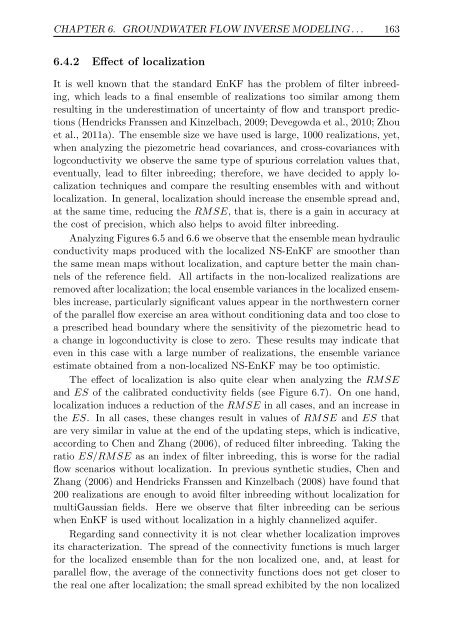Upscaling and Inverse Modeling of Groundwater Flow and Mass ...
Upscaling and Inverse Modeling of Groundwater Flow and Mass ...
Upscaling and Inverse Modeling of Groundwater Flow and Mass ...
You also want an ePaper? Increase the reach of your titles
YUMPU automatically turns print PDFs into web optimized ePapers that Google loves.
CHAPTER 6. GROUNDWATER FLOW INVERSE MODELING . . . 163<br />
6.4.2 Effect <strong>of</strong> localization<br />
It is well known that the st<strong>and</strong>ard EnKF has the problem <strong>of</strong> filter inbreeding,<br />
which leads to a final ensemble <strong>of</strong> realizations too similar among them<br />
resulting in the underestimation <strong>of</strong> uncertainty <strong>of</strong> flow <strong>and</strong> transport predictions<br />
(Hendricks Franssen <strong>and</strong> Kinzelbach, 2009; Devegowda et al., 2010; Zhou<br />
et al., 2011a). The ensemble size we have used is large, 1000 realizations, yet,<br />
when analyzing the piezometric head covariances, <strong>and</strong> cross-covariances with<br />
logconductivity we observe the same type <strong>of</strong> spurious correlation values that,<br />
eventually, lead to filter inbreeding; therefore, we have decided to apply localization<br />
techniques <strong>and</strong> compare the resulting ensembles with <strong>and</strong> without<br />
localization. In general, localization should increase the ensemble spread <strong>and</strong>,<br />
at the same time, reducing the RMSE, that is, there is a gain in accuracy at<br />
the cost <strong>of</strong> precision, which also helps to avoid filter inbreeding.<br />
Analyzing Figures 6.5 <strong>and</strong> 6.6 we observe that the ensemble mean hydraulic<br />
conductivity maps produced with the localized NS-EnKF are smoother than<br />
the same mean maps without localization, <strong>and</strong> capture better the main channels<br />
<strong>of</strong> the reference field. All artifacts in the non-localized realizations are<br />
removed after localization; the local ensemble variances in the localized ensembles<br />
increase, particularly significant values appear in the northwestern corner<br />
<strong>of</strong> the parallel flow exercise an area without conditioning data <strong>and</strong> too close to<br />
a prescribed head boundary where the sensitivity <strong>of</strong> the piezometric head to<br />
a change in logconductivity is close to zero. These results may indicate that<br />
even in this case with a large number <strong>of</strong> realizations, the ensemble variance<br />
estimate obtained from a non-localized NS-EnKF may be too optimistic.<br />
The effect <strong>of</strong> localization is also quite clear when analyzing the RMSE<br />
<strong>and</strong> ES <strong>of</strong> the calibrated conductivity fields (see Figure 6.7). On one h<strong>and</strong>,<br />
localization induces a reduction <strong>of</strong> the RMSE in all cases, <strong>and</strong> an increase in<br />
the ES. In all cases, these changes result in values <strong>of</strong> RMSE <strong>and</strong> ES that<br />
are very similar in value at the end <strong>of</strong> the updating steps, which is indicative,<br />
according to Chen <strong>and</strong> Zhang (2006), <strong>of</strong> reduced filter inbreeding. Taking the<br />
ratio ES/RMSE as an index <strong>of</strong> filter inbreeding, this is worse for the radial<br />
flow scenarios without localization. In previous synthetic studies, Chen <strong>and</strong><br />
Zhang (2006) <strong>and</strong> Hendricks Franssen <strong>and</strong> Kinzelbach (2008) have found that<br />
200 realizations are enough to avoid filter inbreeding without localization for<br />
multiGaussian fields. Here we observe that filter inbreeding can be serious<br />
when EnKF is used without localization in a highly channelized aquifer.<br />
Regarding s<strong>and</strong> connectivity it is not clear whether localization improves<br />
its characterization. The spread <strong>of</strong> the connectivity functions is much larger<br />
for the localized ensemble than for the non localized one, <strong>and</strong>, at least for<br />
parallel flow, the average <strong>of</strong> the connectivity functions does not get closer to<br />
the real one after localization; the small spread exhibited by the non localized


